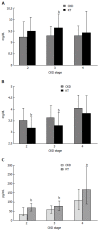Mineral and bone disorder after kidney transplantation
- PMID: 26722650
- PMCID: PMC4689933
- DOI: 10.5500/wjt.v5.i4.231
Mineral and bone disorder after kidney transplantation
Abstract
After successful kidney transplantation, accumulated waste products and electrolytes are excreted and regulatory hormones return to normal levels. Despite the improvement in mineral metabolites and mineral regulating hormones after kidney transplantation, abnormal bone and mineral metabolism continues to present in most patients. During the first 3 mo, fibroblast growth factor-23 (FGF-23) and parathyroid hormone levels decrease rapidly in association with an increase in 1,25-dihydroxyvitamin D production. Renal phosphate excretion resumes and serum calcium, if elevated before, returns toward normal levels. FGF-23 excess during the first 3-12 mo results in exaggerated renal phosphate loss and hypophosphatemia occurs in some patients. After 1 year, FGF-23 and serum phosphate return to normal levels but persistent hyperparathyroidism remains in some patients. The progression of vascular calcification also attenuates. High dose corticosteroid and persistent hyperparathyroidism are the most important factors influencing abnormal bone and mineral metabolism in long-term kidney transplant (KT) recipients. Bone loss occurs at a highest rate during the first 6-12 mo after transplantation. Measurement of bone mineral density is recommended in patients with estimated glomerular filtration rate > 30 mL/min. The use of active vitamin D with or without bisphosphonate is effective in preventing early post-transplant bone loss. Steroid withdrawal regimen is also beneficial in preservation of bone mass in long-term. Calcimimetic is an alternative therapy to parathyroidectomy in KT recipients with persistent hyperparathyroidism. If parathyroidectomy is required, subtotal to near total parathyroidectomy is recommended. Performing parathyroidectomy during the waiting period prior to transplantation is also preferred in patients with severe hyperparathyroidism associated with hypercalcemia.
Keywords: Bone mineral density; Phosphatonin; Phosphaturia; Renal transplantation; Tertiary hyperparathyroidism.
Figures


Similar articles
-
Hyperparathyroidism and increased fractional excretion of phosphate predict allograft loss in long-term kidney transplant recipients.Clin Exp Nephrol. 2017 Oct;21(5):926-931. doi: 10.1007/s10157-016-1370-9. Epub 2016 Dec 16. Clin Exp Nephrol. 2017. PMID: 27981393
-
A Randomized Study Comparing Parathyroidectomy with Cinacalcet for Treating Hypercalcemia in Kidney Allograft Recipients with Hyperparathyroidism.J Am Soc Nephrol. 2016 Aug;27(8):2487-94. doi: 10.1681/ASN.2015060622. Epub 2015 Dec 8. J Am Soc Nephrol. 2016. PMID: 26647424 Free PMC article. Clinical Trial.
-
Treatment of Persistent Hypercalcemia and Hyperparathyroidism With Cinacalcet After Successful Kidney Transplantation.Transplant Proc. 2016 Jun;48(5):1623-5. doi: 10.1016/j.transproceed.2016.01.044. Transplant Proc. 2016. PMID: 27496458
-
Management of mineral and bone disorders in renal transplant recipients.Nephrology (Carlton). 2017 Mar;22 Suppl 2:65-69. doi: 10.1111/nep.13028. Nephrology (Carlton). 2017. PMID: 28429555 Review.
-
Surgical treatment of persistent hyperparathyroidism after renal transplantation.Ann Surg. 2008 Jul;248(1):18-30. doi: 10.1097/SLA.0b013e3181728a2d. Ann Surg. 2008. PMID: 18580203 Review.
Cited by
-
Vitamin D-Mediated Hypercalcemia: Mechanisms, Diagnosis, and Treatment.Endocr Rev. 2016 Oct;37(5):521-547. doi: 10.1210/er.2016-1070. Epub 2016 Sep 2. Endocr Rev. 2016. PMID: 27588937 Free PMC article. Review.
-
Bone Mineral Density Changes in Long-Term Kidney Transplant Recipients: A Real-Life Cohort Study of Native Vitamin D Supplementation.Nutrients. 2022 Jan 13;14(2):323. doi: 10.3390/nu14020323. Nutrients. 2022. PMID: 35057505 Free PMC article.
-
Mineral and bone disorder after kidney transplantation (KTx).J Bras Nefrol. 2021 Dec 3;43(4 Suppl 1):674-679. doi: 10.1590/2175-8239-JBN-2021-S113. eCollection 2021. J Bras Nefrol. 2021. PMID: 34910805 Free PMC article. No abstract available.
-
Fractures and Subsequent Graft Loss and Mortality among Older Kidney Transplant Recipients.J Am Geriatr Soc. 2019 Aug;67(8):1680-1688. doi: 10.1111/jgs.15962. Epub 2019 May 6. J Am Geriatr Soc. 2019. PMID: 31059126 Free PMC article.
-
Is low pre-transplant parathyroid hormone a risk marker for cardiovascular disease in long-term follow-up of renal transplant recipients?Clin Exp Nephrol. 2018 Oct;22(5):1188-1197. doi: 10.1007/s10157-018-1543-9. Epub 2018 Feb 24. Clin Exp Nephrol. 2018. PMID: 29478201 Free PMC article.
References
-
- Bhan I, Shah A, Holmes J, Isakova T, Gutierrez O, Burnett SM, Jüppner H, Wolf M. Post-transplant hypophosphatemia: Tertiary ‘Hyper-Phosphatoninism’? Kidney Int. 2006;70:1486–1494. - PubMed
-
- Evenepoel P, Naesens M, Claes K, Kuypers D, Vanrenterghem Y. Tertiary ‘hyperphosphatoninism’ accentuates hypophosphatemia and suppresses calcitriol levels in renal transplant recipients. Am J Transplant. 2007;7:1193–1200. - PubMed
-
- Barros X, Torregrosa JV, Martínez de Osaba MJ, Casals G, Paschoalin R, Durán CE, Campistol JM. Earlier decrease of FGF-23 and less hypophosphatemia in preemptive kidney transplant recipients. Transplantation. 2012;94:830–836. - PubMed
Publication types
LinkOut - more resources
Full Text Sources
Other Literature Sources

